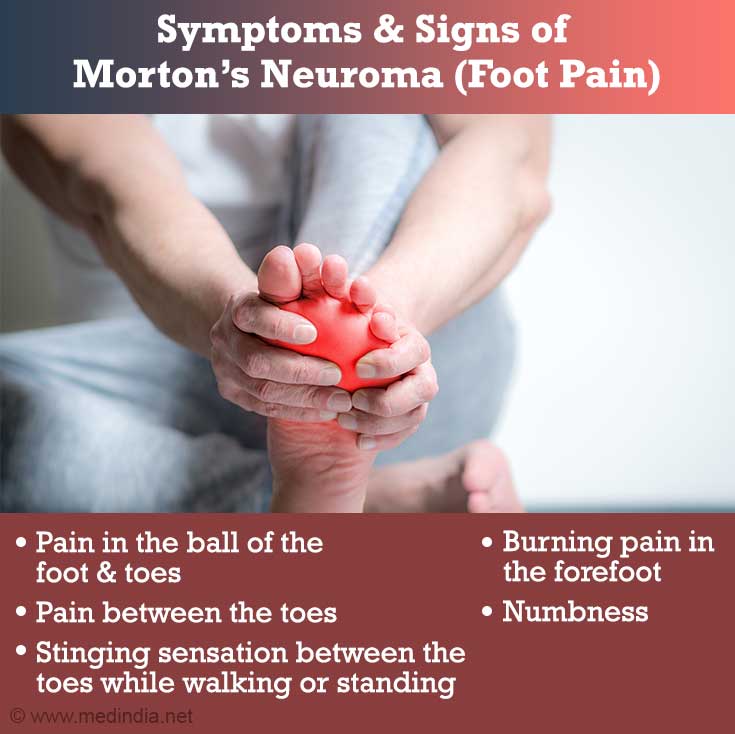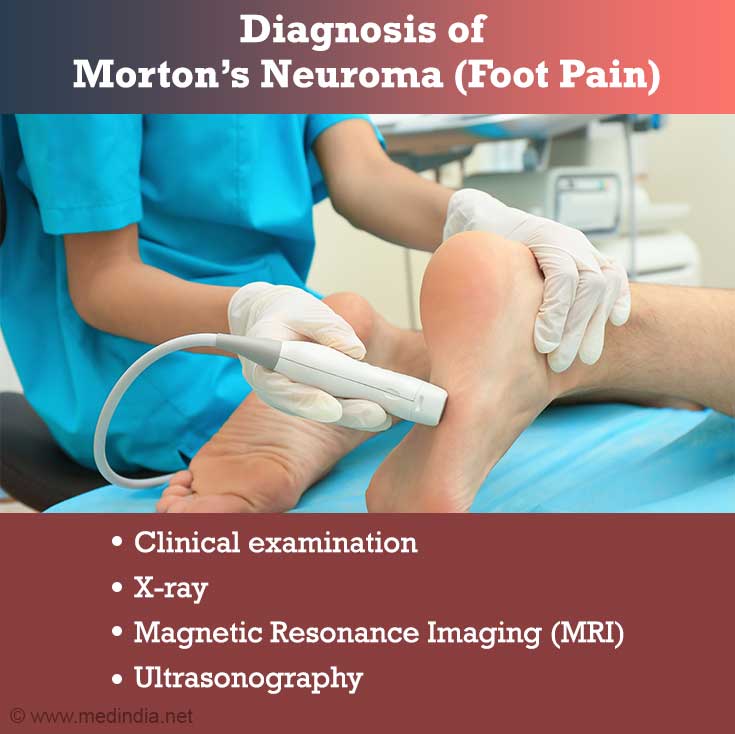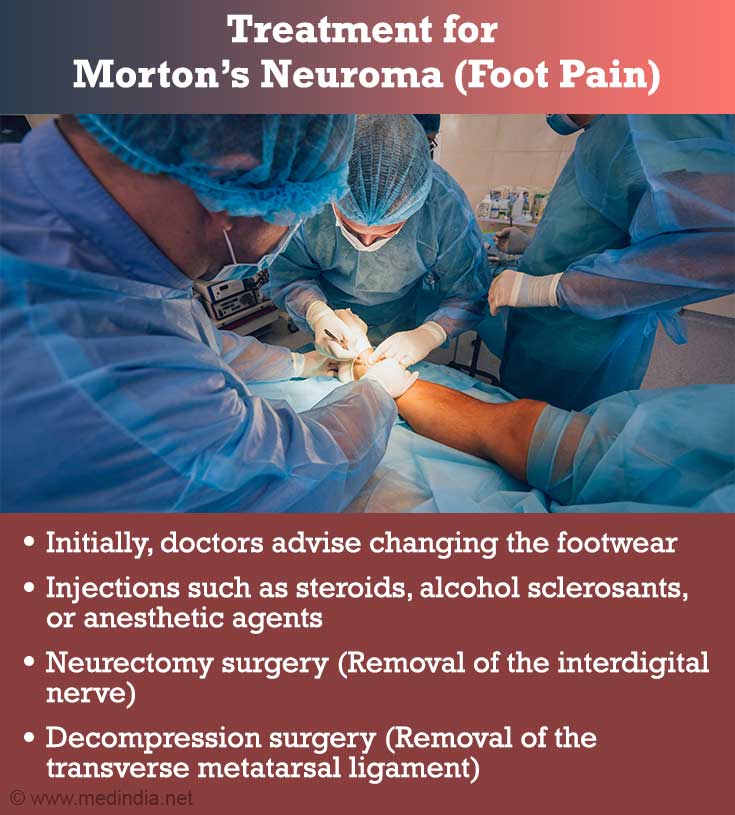- Information About Morton's Neuroma - (http://orthoinfo.aaos.org/topic.cfm?topic=a00158)
- Morton's Neuroma - (https://my.clevelandclinic.org/health/diseases_conditions/hic_mortons_neuroma)
- About Morton's neuroma - (http://www.nhs.uk/conditions/mortonsneuroma/pages/introduction.aspx)
- Morton's Neuroma (Intermetatarsal Neuroma) - (http://www.foothealthfacts.org/footankleinfo/mortons-neuroma.htm)
- More on Morton's neuroma - (http://www.mayoclinic.org/diseases-conditions/mortons-neuroma/basics/definition/con-20026482)
- O’Connor KM, Johnson JE, McCormick JJ, Klein SE. Correlation of clinical, operative, and histopathologic diagnosis of interdigital neuroma and the cost of routine diagnosis. Foot Ankle Int. 2015. pii: 1071100715603118.
- Torres-Claramunt R, Ginés A, Pidemunt G, Puig L, de Zabala S. MRI and ultrasonography in Morton’s neuroma: Diagnostic accuracy and correlation. Indian Journal of Orthopaedics. 2012;46(3):321-325. doi:10.4103/0019-5413.96390.
- Fazal MA, Khan I, Thomas C. Ultrasonography and magnetic resonance imaging in the diagnosis of Morton’s neuroma. J Am Podiatr Med Assoc. 2012;102(3):184-186.
- Kasparek M, Schneider W. Surgical treatment of Morton’s neuroma: clinical results after open excision. Int Orthop. 2013;37(9):1857-1861. doi:10.1007/s00264-013-2002-6.
- Morgan P, Monaghan W, Richards S. A systematic review of ultrasound-guided and non-ultrasound-guided therapeutic injections to treat Morton’s neuroma. J Am Podiatr Med Assoc. 2014;104(4):337-348.
- Kasparek M, Schneider W. Transection of the deep metatarsal transverse ligament in Morton's neuroma surgery does not increase risk of splayfoot development. Int Orthop. 2015. [Epub ahead of print].
- Gurdezi S, White T, Ramesh P. Alcohol injection for Morton’s neuroma: a five-year follow-up. Foot Ankle Int. 2013;34(8):1064-1067.
- Davis F. Therapeutic Massage Provides Pain Relief to a Client with Morton's Neuroma: A Case Report. Int J Ther Massage Bodywork. 2012;5(2):12-19.
What is Morton's Neuroma?
Morton’s neuroma is a condition that causes continuous pain in the ball of the foot that lies below the toes. People feel like they have stamped a stone or a fold of a sock. It occurs due to thickening of the interdigital nerve, which supplies sensations to the toes. The thickening is possibly a result of pressure on the nerve by the deep transverse ligament, the ligament which connects the bones of adjacent toes.
Women are 8 to 10 times more likely to get this condition compared with men. They tend to experience this pain when they are over 50 years of age. The nerve between the 3rd and 4th toes is commonly affected.
In 1835 and 1845, two independent physicians Civinini and Durlacher described an association between pain in the foot and a neuroma or a benign nerve swelling. Morton’s neuroma is named after Thomas George Morton who described the condition in 1876.
What are the Causes of Morton's Neuroma?
One of the main reasons for Morton’s neuroma is the kind of footwear that is used. Some footwear can squeeze the toes together, apply pressure on the tissue below the toes, or restrict the movement of toes. All these conditions predispose an individual to Morton’s neuroma. Heel or pointed shoes give rise to this condition. This explains the high rate of incidence of Morton’s neuroma among women.
Certain sporting activities, such as racquetball, tennis, and running tend to make an individual more prone to developing Morton’s neuroma. Instability within toes, flat feet, arched foot, are foot conditions that make an individual more prone to developing Morton’s neuroma.
What are the Symptoms and Signs of Morton's Neuroma?
As observed in the description of Morton’s neuroma, the main symptom of the condition is a pain in the ball of the foot and toes. Some of the symptoms include, pain between the toes, stinging sensation between the toes while walking or standing, sensation of the presence of a marble or a folded sock below the toes, burning pain in the forefoot in the region of the toes, and numbness.

One thing that should be noted here is that there is no outward physical sign that can be clearly attributed to the condition.
How to Diagnose Morton's Neuroma?
The doctor applies pressure in the region between toes to examine the pain that is experienced by patients. The doctor also examines for any clicks between toes, or the presence of a mass between toes. The results from a clinical examination provide an accurate diagnosis. Currently, clinical examination is still the best way to diagnose Morton’s neuroma in a patient. This is due to the fact that there are many patients who may have asymptomatic neuromas (absence of symptoms). X-rays can identify if there is any fracture or arthritis that may cause pain in the feet.
Patients are asked to undergo magnetic resonance imaging or Ultrasonography in certain cases to detect the presence of a lesion or neuroma. A recent study by Dr. Torres-Claramunt and colleagues compared the efficacy of ultrasonography and magnetic resonance imaging (MRI). The study found MRI to have a greater sensitivity in diagnosing Morton’s neuroma compared with ultrasonography. In contrast, another study by Fazal MA et al, found ultrasonography to be more sensitive in detecting small neuromas. In conclusion, both techniques are imaging techniques that help in detecting the size and presence of neuromas.

How is Morton's Neuroma Treated?
In the initial stages, Morton’s neuroma is treated with orthoses or by changing the kind of footwear used. Orthoses, which include pads or inserts that separate the bones of the feet, relieve the stress or pressure on the nerves. Footwear, such as heels or pointed shoes, is a cause for Morton’s neuroma. Hence, it is useful to wear wide flat shoes to give more room to the toes and bones to separate out. This relieves the stress on the nerves.
However, when the above non-medical strategies do not work out, injections or surgery is the next option. Injections administered for Morton’s neuroma contain Corticosteroids, alcohol sclerosants, or anesthetic agents. It has been observed that corticosteroid injections to the neuroma, when guided by ultrasound, are very effective in providing both short and long-term relief. In addition, this procedure may reduce the requirement for surgical intervention or additional alcohol injections. Alcohol sclerosant injections are effective for short-term relief. However, this treatment is associated with morbidity.
One of the surgical approaches to treat Morton’s neuroma is the removal of the interdigital nerve (neurectomy). A single neuroma can be removed effectively. However, the effectiveness of the approach reduces with multiple neuromas. Loss of sensation due to the procedure is not a deterrent to patients as they are relieved of the discomfort and pain. There is a low chance of recurrence of neuromas with this surgical procedure.

Another surgical procedure involves the removal of the transverse metatarsal ligament that applies pressure on the interdigital nerve. This procedure is called decompression surgery. There are no major complications involved with the procedure. It may also be combined with neurectomy.
Health Tips – Prevention of Morton's Neuroma
Based on the information in this article on Morton’s neuroma, one of the ways that we can avoid Morton’s neuroma is by changing the kind of footwear that is worn. Shoes with pointed ends that squeeze toes and high heels should be avoided. Individuals who are involved in active sports, such as tennis, soccer, hiking, running, should take a break from these activities. Anti-inflammatory medications may be used to relieve the pain and swelling. Ice massages may be used to relieve the pain in the foot.









